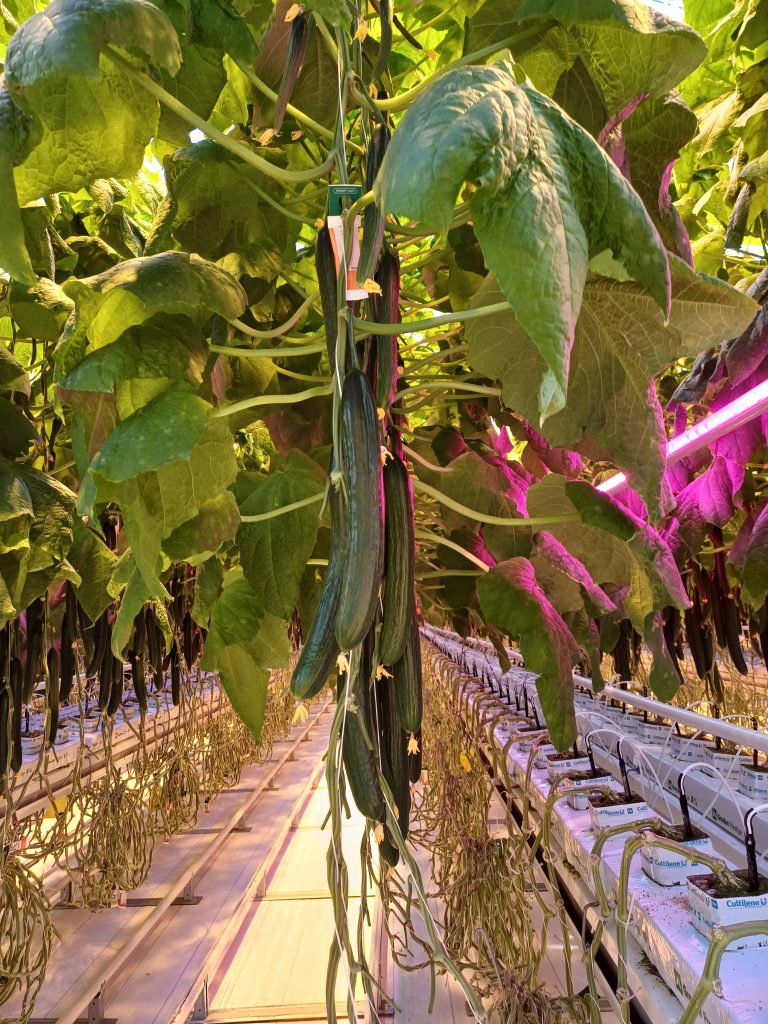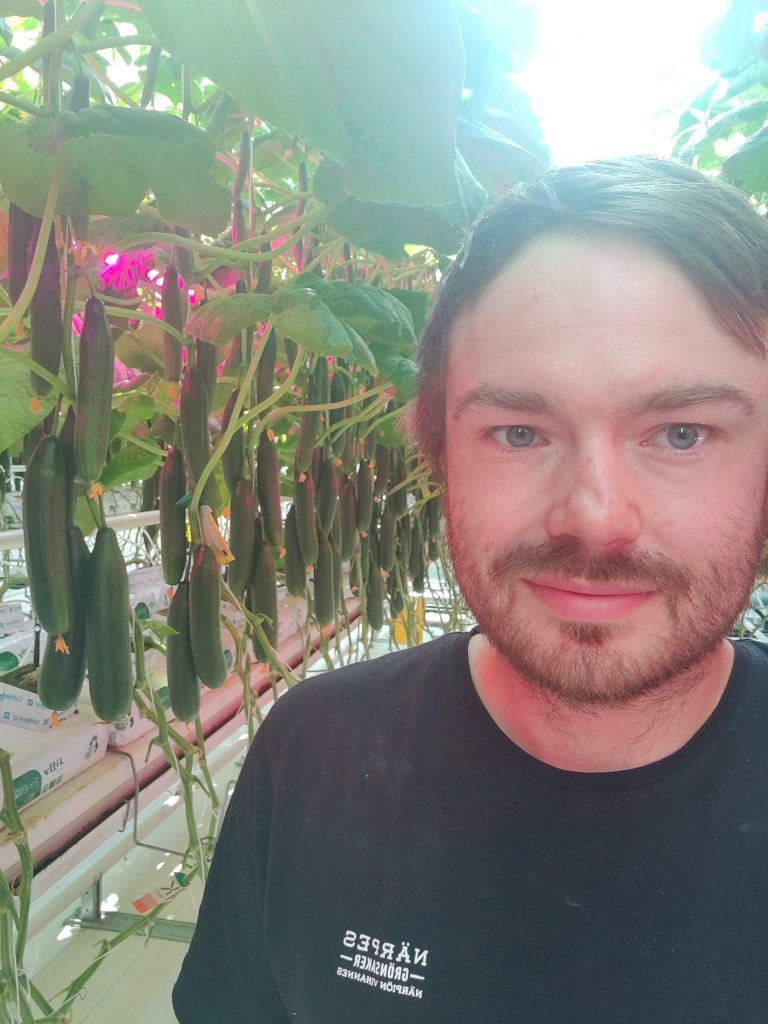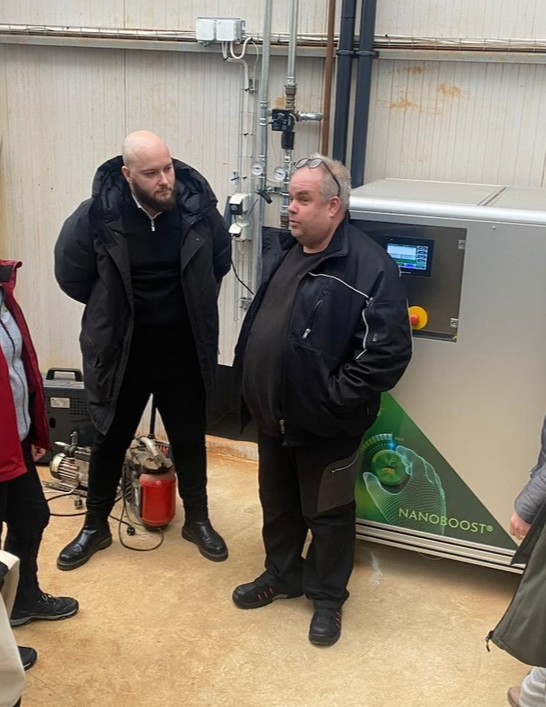
Johan Prinsén is a cucumber and tomato farm located in Närpiö, Finland, operating with a philosophy of maximum efficiency and meticulous care. The farm gained attention in early 2025 for setting a world record in cucumber production, measured in kilograms per square meter. According to HortiDaily, the average yield in the Netherlands is 70.52 kg/m², while Oy Johan Prinsén Ab achieved an astonishing 244 kg/m² in 2024.
Can the record still be improved? This interview explores what has happened at the farm during the 2025 growing season.
Johan Prinsén Ab – Three Generations of Vegetable Farming
Located in Piolahti, Närpiö, the Johan Prinsén farm has been growing vegetables for over three decades. The company has been actively involved in the Närpiön Vihannes growers’ cooperative since its founding, and all products are sold through the cooperative.
In addition to father Johan, the farm is run by his two sons. Jesper Prinsén shares insights into the current state of the farm:
“We currently grow cucumbers in three different greenhouses,” Jesper explains. “The largest one was built in 2015 and is 1.08 hectares in size. The smaller ones were built in 2006 and 2023, with sizes of 0.28 and 0.72 hectares respectively. All three greenhouses operate year-round, though they have slightly different lighting setups,” Jesper adds.

Lighting Technology Supporting Year-Round Cultivation
Lighting plays a crucial role in year-round cultivation. Johan Prinsén uses energy-efficient LED lights, while the smaller greenhouses still utilize hybrid lighting—both traditional HPS lamps and LEDs. In January 2025, the largest greenhouse (1.08 ha) transitioned fully to LED lighting.
“We replace the cucumber crops three times a year in all greenhouses, but never all at once. It’s important for us to maintain continuous product delivery to our customers,” Jesper emphasizes.
Benefits of Nanobubbles Observed at the Farm
The farm has always aimed to evolve and improve its cultivation practices, relying on top-tier partners. The Nanoboost system was installed in August 2024.
“We learned about EOD’s Nanoboost system through Schetelig, with whom we’ve had a close partnership for years. We wanted to invest in Nanoboost because we believe—and have now seen firsthand—that oxygen-rich water promotes plant health,” Jesper explains. “Our collaboration with Schetelig and EOD has been smooth, and we haven’t encountered any major issues with the device.”

“We wanted to invest in Nanoboost because we believe—and have now seen firsthand—that oxygen-rich water promotes plant health.” – Jesper Prinsén
During the winter of 2024–2025, the farm experienced some Pythium disease, but according to Jesper, the issues were relatively minor. They believe this was due to the more oxygen-rich water. The crops have been healthier, and yields have been increasing in recent years. Final figures for 2025 are not yet available.
“We haven’t done detailed calculations on savings or the impact of nanobubbles. But since the yield per square meter has increased after implementing Nanoboost, profitability is likely to improve as well,” Jesper estimates.
Step-by-Step Cultivation Development
To keep changes manageable and effects clear, the farm avoids implementing multiple changes at once. Prinsén follows a one-step-at-a-time approach.
“In the newest 0.72-hectare greenhouse, we’ve made only one change in the past year—the introduction of the Nanoboost system. We believe it’s important to proceed one change at a time to better observe the effects,” Jesper says. “We’re willing to wait for results,” he emphasizes.
Last summer’s challenging weather conditions also affected the Prinsén greenhouses.
“During the heatwave, some cucumber plants died, and we experienced a slight dip in yield. However, it wasn’t a disaster,” Jesper notes. He believes oxygen-rich water helped the plants better withstand the heat.
“Only one change was made in the greenhouse this past year—the introduction of the Nanoboost system. We believe it’s important to proceed one change at a time to better observe the effects.” – Jesper Prinsén
Toward Even Better Yields
“We feel that Nanoboost helps us achieve even better yields through improved plant health,” Jesper concludes.
Text and photos: Eija Lankinen and EOD archive
With the Finnish EOD’s oxygen nanobubble solution, irrigation water gains properties that promote plant well-being. The solution strengthens plants’ natural defenses and reduces the need for pesticides—protecting soil and waterways from unnecessary chemical loads. At the same time, profitability improves as yield and quality increase significantly.
Interested?
Please contact us for further information.
